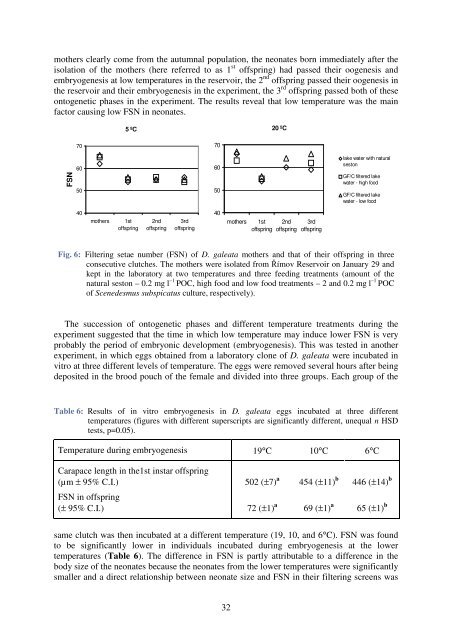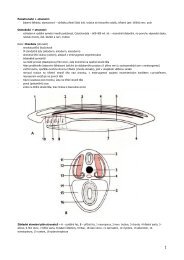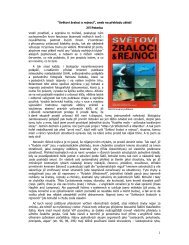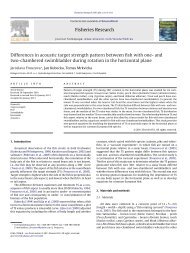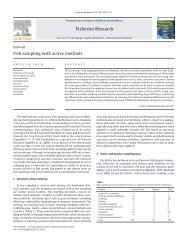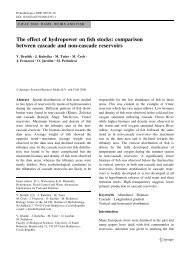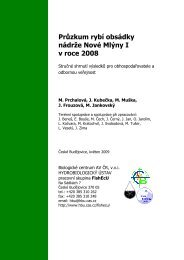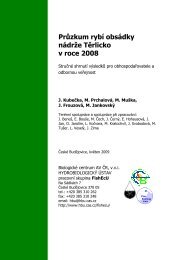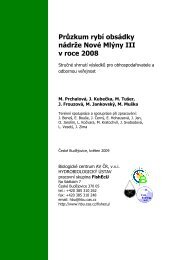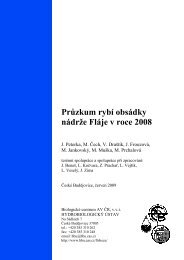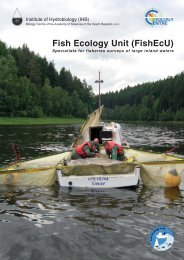anglicky - Institute of Hydrobiology
anglicky - Institute of Hydrobiology
anglicky - Institute of Hydrobiology
You also want an ePaper? Increase the reach of your titles
YUMPU automatically turns print PDFs into web optimized ePapers that Google loves.
mothers clearly come from the autumnal population, the neonates born immediately after the<br />
isolation <strong>of</strong> the mothers (here referred to as 1 st <strong>of</strong>fspring) had passed their oogenesis and<br />
embryogenesis at low temperatures in the reservoir, the 2 nd <strong>of</strong>fspring passed their oogenesis in<br />
the reservoir and their embryogenesis in the experiment, the 3 rd <strong>of</strong>fspring passed both <strong>of</strong> these<br />
ontogenetic phases in the experiment. The results reveal that low temperature was the main<br />
factor causing low FSN in neonates.<br />
5 ºC<br />
20 ºC<br />
FSN<br />
70<br />
60<br />
50<br />
70<br />
60<br />
50<br />
lake water with natural<br />
seston<br />
GF/C filtered lake<br />
water - high food<br />
GF/C filtered lake<br />
water - low food<br />
40<br />
mothers<br />
1st<br />
<strong>of</strong>fspring<br />
2nd<br />
<strong>of</strong>fspring<br />
3rd<br />
<strong>of</strong>fspring<br />
40<br />
mothers<br />
1st<br />
<strong>of</strong>fspring<br />
2nd<br />
<strong>of</strong>fspring<br />
3rd<br />
<strong>of</strong>fspring<br />
Fig. 6: Filtering setae number (FSN) <strong>of</strong> D. galeata mothers and that <strong>of</strong> their <strong>of</strong>fspring in three<br />
consecutive clutches. The mothers were isolated from Římov Reservoir on January 29 and<br />
kept in the laboratory at two temperatures and three feeding treatments (amount <strong>of</strong> the<br />
natural seston – 0.2 mg l –1 POC, high food and low food treatments – 2 and 0.2 mg l –1 POC<br />
<strong>of</strong> Scenedesmus subspicatus culture, respectively).<br />
The succession <strong>of</strong> ontogenetic phases and different temperature treatments during the<br />
experiment suggested that the time in which low temperature may induce lower FSN is very<br />
probably the period <strong>of</strong> embryonic development (embryogenesis). This was tested in another<br />
experiment, in which eggs obtained from a laboratory clone <strong>of</strong> D. galeata were incubated in<br />
vitro at three different levels <strong>of</strong> temperature. The eggs were removed several hours after being<br />
deposited in the brood pouch <strong>of</strong> the female and divided into three groups. Each group <strong>of</strong> the<br />
Table 6: Results <strong>of</strong> in vitro embryogenesis in D. galeata eggs incubated at three different<br />
temperatures (figures with different superscripts are significantly different, unequal n HSD<br />
tests, p=0.05).<br />
Temperature during embryogenesis 19°C 10°C 6°C<br />
Carapace length in the1st instar <strong>of</strong>fspring<br />
(µm ± 95% C.I.) 502 (±7) a 454 (±11) b 446 (±14) b<br />
FSN in <strong>of</strong>fspring<br />
(± 95% C.I.) 72 (±1) a 69 (±1) a 65 (±1) b<br />
same clutch was then incubated at a different temperature (19, 10, and 6°C). FSN was found<br />
to be significantly lower in individuals incubated during embryogenesis at the lower<br />
temperatures (Table 6). The difference in FSN is partly attributable to a difference in the<br />
body size <strong>of</strong> the neonates because the neonates from the lower temperatures were significantly<br />
smaller and a direct relationship between neonate size and FSN in their filtering screens was<br />
32


